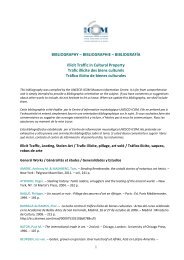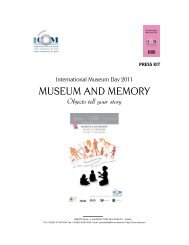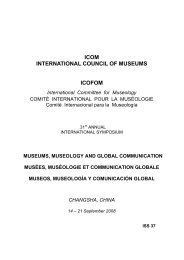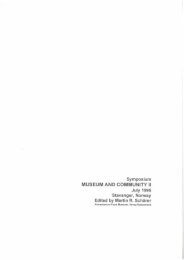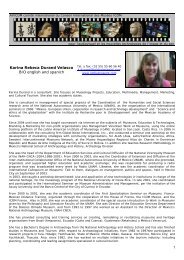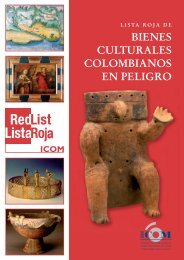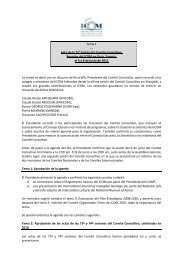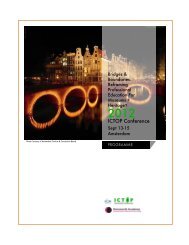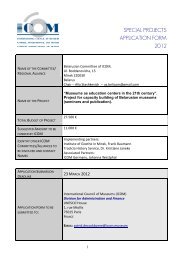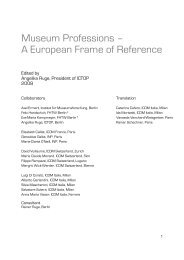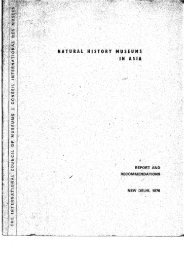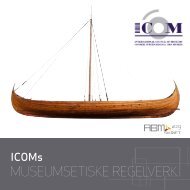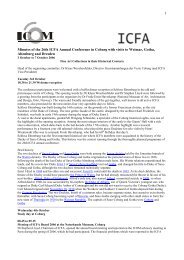Key Concepts of Museology - ICOM
Key Concepts of Museology - ICOM
Key Concepts of Museology - ICOM
You also want an ePaper? Increase the reach of your titles
YUMPU automatically turns print PDFs into web optimized ePapers that Google loves.
a chair in a museum <strong>of</strong> decorative<br />
arts, which supposes an established<br />
distinction between the functional<br />
chair and the chair-object. Their<br />
function has been removed and they<br />
have been ‘decontextualised’, which<br />
means that from now on they will no<br />
longer serve their original purpose<br />
but have entered a symbolic order<br />
which gives them new meaning, leading<br />
Krzyszt<strong>of</strong> Pomian to call such<br />
objects semiophores (“carriers <strong>of</strong><br />
signifi cance”) and to attribute a new<br />
value to them – which is fi rst <strong>of</strong> all<br />
purely a museal value but which can<br />
become an economic value. They<br />
thus become sacred (consecrated)<br />
evidence <strong>of</strong> culture.<br />
4. Exhibitions refl ect these choices.<br />
For semiologists like Jean Davallon<br />
“Musealia can be considered less<br />
as things (from the point <strong>of</strong> view <strong>of</strong><br />
their physical reality) than as language<br />
beings (they are defi ned, recognized<br />
as worthy <strong>of</strong> being safeguarded and<br />
displayed) and as supports <strong>of</strong> social<br />
practices (they are collected, catalogued,<br />
displayed etc.)” (Davallon,<br />
1992). Objects can thus be used<br />
as signs, just like words in speech,<br />
when they are used in an exhibition.<br />
But objects are not just signs, since<br />
by their presence alone they can be<br />
directly perceived by our senses.<br />
For this reason the term real thing<br />
is <strong>of</strong>ten used to indicate a museum<br />
object exhibited because <strong>of</strong> its power<br />
<strong>of</strong> “authentic presence”, that is “The<br />
real things <strong>of</strong> the museum language<br />
are those things which we present as<br />
what they are, not as models or ima-<br />
ges or representations <strong>of</strong> something<br />
else.” (Cameron, 1968). For various<br />
reasons (sentimental, aesthetic, etc.)<br />
we have an intuitive relationship with<br />
that which is displayed. The noun<br />
exhibit refers to a real thing which is<br />
displayed, but also to anything displayable<br />
(a sound, photographic or<br />
fi lm document, a hologram, a reproduction,<br />
a model, an installation or<br />
a conceptual model) (see Exhibition).<br />
5. A certain tension exists between<br />
the real thing and its substitute.<br />
Regarding this we must note that for<br />
some people the semiophore object<br />
is only a carrier <strong>of</strong> meaning when<br />
it is presented for itself, and not<br />
through a substitute. Wide as it may<br />
seem, this purely reist concept does<br />
not take account <strong>of</strong> either the origins<br />
<strong>of</strong> museums in the Renaissance<br />
(see Museum) or the development<br />
and diversity reached by museology<br />
during the 19 th century. Nor does<br />
it allow us to take into account the<br />
work <strong>of</strong> a number <strong>of</strong> museums whose<br />
activities are essentially on other<br />
support systems such as the internet<br />
or duplicated media, or more<br />
generally all the museums made<br />
<strong>of</strong> substitutes such as museums <strong>of</strong><br />
casts (gypsotheques), collections <strong>of</strong><br />
models, collections <strong>of</strong> wax reproductions<br />
(ceratheques), or science<br />
centres which display mostly models.<br />
Since these objects were considered<br />
as elements <strong>of</strong> a language, they can<br />
be used to create lecture exhibitions,<br />
but they are not always adequate to<br />
sustain the entire lecture. We must<br />
therefore envisage other elements<br />
63



